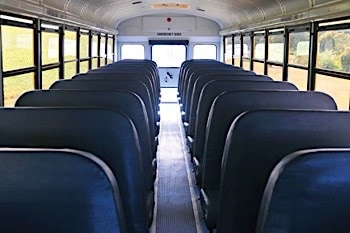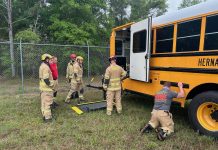A newly proposed federal law that would essentially prohibit seclusion and restraint practices on students nationwide may have serious unintended consequences for the school bus.
Sen. Tom Harkin (D-Iowa) last year introduced Senate Bill 2020, the “Keeping All Students Safe Act,” which would ban seclusion and restraint unless the student poses an immediate danger of serious bodily injury to themselves or other students. According to Office of Civil Rights data released in March, at least 38,792 students were physically restrained during the 2009-2010 school year.
The debate over seclusion and restraint practices has picked up steam following a 2009 U.S. Government Accountability Office report. It found hundreds of cases of alleged abuse and death of pupils related to seclusion and restraint practices over the past 20 years, mostly involving children with disabilities, and no federal laws on the books restricting the use of seclusion and restraint practices in public and private schools.
The U.S. Department of Education also released a 2009 report outlining state-by-state practices for seclusion and restraint that showed a hodgepodge of different guidelines across the country.
Melinda Jacobs, a Tennessee-based attorney specializing in special education issues, said Harkin is known as “Mr. IDEA” for long supporting the Individuals with Disabilities Education Act. Harkin also introduced the 1990 Americans with Disabilities Act.
“No one wants to see a child inappropriately secluded or restrained,” Jacobs said. “(But) if Congress passes this in line with what Sen. Harkin proposes, it will make it nearly impossible to restrain any student under any circumstances.”
She added that the unintended consequence could lead to more severely disabled students being placed in restrictive environments outside the public school system and district transportation. The conclusion is similar to an American Association of School Administrators (AASA) position in its March report “Keeping Schools Safe: How Seclusion and Restraint Protects Students and School Personnel.” AASA said that if school districts were unable to occasionally use the techniques, then students with severe behavioral or emotional disorders “would have to be institutionalized or sent to private facilities where they may not have the same rights and services available to them.”
Disability advocacy group TASH said the AASA report was “unsubstantiated, ill-informed and reckless.” It continued that seclusion and restraint are “most often used for convenience and punishment, not for emergencies. Such techniques are disproportionately used on the most vulnerable children: those with significant disabilities, between ages 6 and 10 and children with no verbal expression.”
Linda Bluth, NAPT immediate past president and lead quality assurance specialist with Maryland State Department of Education’s Division of Special Education/Early Intervention Services, recommended school transporters discuss the implications for the use of child safety restraint systems on school buses with special educators. She explained that the IEP team is best suited for approving the use of CSRS and understanding the term in the context used by NHTSA.
The use of CSRS should also only be made on a case-by-case basis and be included in a student’s Individualized Education Program (IEP) in the section documenting transportation as a related service, Bluth said. Transportation staff should also avoid making unilateral decisions.
Jacobs noted that Harkin’s bill also would prohibit seclusion and restraint as a planned intervention from being written into a student’s IEP. She said that during her 27 years working on special education issues she has encountered many school districts, teachers, administrators and other staff who are well trained using restraining techniques that have benefitted students and allowed them to stay in a less restrictive environment. “It should be done properly by people who are well trained, and parents should be involved,” she added.
Jacobs, however, was concerned about the bill’s language that prohibits the seclusion and restraint of any student unless they are in immediate danger of inflicting serious bodily injury, which is a legal term referring to “a serious risk of death, protracted loss for enjoyment of a bodily organ, member or mental faculty or extreme physical pain.”
“If you’re in the classroom or on the bus, how do you know if the attack is bad enough in that split second?” Jacobs said. “How does a bus driver or aide on a bus know if it’s bad enough to restrain them? Is the student going to break someone’s jaw or is it just a slap (to) the head? I’m worried that the legal standard is far too high and it’s unworkable on a practical level.”
Rhonda Davis, transportation director of Lake Travis Independent School District in Austin, Texas, said her department uses restraint equipment as outlined during the student’s Admission, Review and Dismissal (ARD) meeting, which is used statewide to determine the services and special provisions for special education students.
Transportation staff members attend the ARD meetings and ask questions about the best procedure and technique to calm students and when restraint should be used as part of the student’s IEP.
Davis, who is also president of the Texas Association for Pupil Transportation, said training on seclusion and restraint has picked up recently as awareness has grown. Lake Travis special needs monitors and drivers are required to undergo Satori Alternative to Managing Aggression training to learn the proper techniques and ways to restrain a child, if necessary, Davis said.
“Everyone has come to realize the importance of training our employees and accessing them with the knowledge and skills to address these situations when they happen to come up on the bus,” Davis said. “So, we have been seeing a lot of training in the last three to four years. We know that we have to arm our employees with these skills so they are able to handle these situations on the bus when it arrives.”
Read the Keeping All Students Safe Act at www.opencongress.org/bill/112-s2020/text.
















